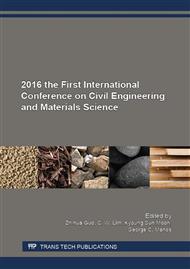p.109
p.114
p.119
p.124
p.129
p.134
p.139
p.143
p.151
Influence of the Anchorage of PBO-FRCM Composites on the Effectiveness of Behaviour of Shearing Beams
Abstract:
The shear capacity of reinforced concrete beams strengthened with cement based composite materials (FRCM system) was investigated in this paper. The analysis refers to PBO-FRCM system made by PBO fibres (p-Phenylene Benzobis Oxazole) and cement based mortar. The use of cement mortar is connected with the slip phenomenon that occurs between the matrix layer and the fibres. This phenomenon leads to premature debonding of the ends of the composite and the loss of the shear capacity. To prevent this, designed end-anchorage systems is needed. Therefore, the laboratory tests on reinforced concrete beams strengthened in a shear with PBO-FRCM system were conducted. At this aim tests on three strengthened RC beams with different end-anchorages systems have been preformed and obtained results discussed. The experimental results revealed that the use of FRCM composites increased the shear capacity and construction of end-anchorage of composite had an impact on shear capacity.
Info:
Periodical:
Pages:
129-133
Citation:
Online since:
August 2016
Authors:
Price:
Сopyright:
© 2016 Trans Tech Publications Ltd. All Rights Reserved
Share:
Citation:


